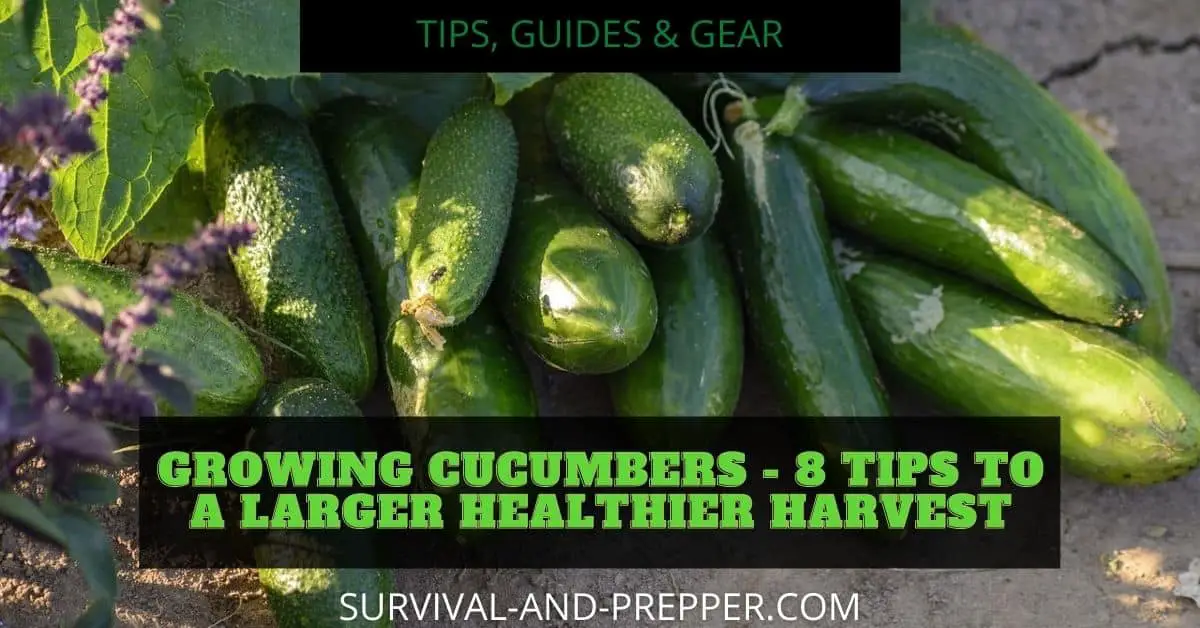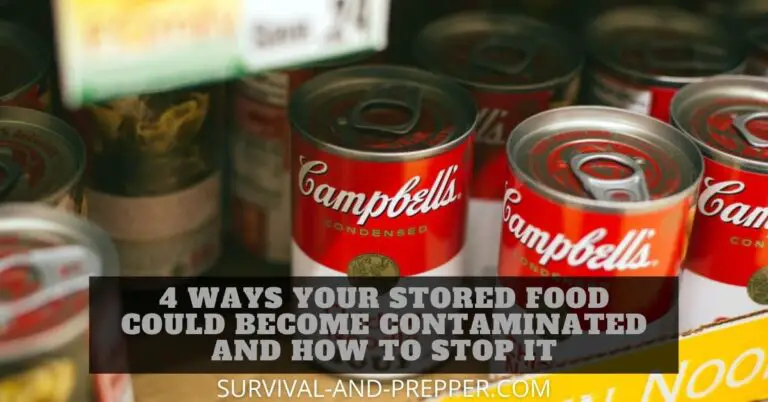Growing Cucumbers – 8 Tips for Larger Healthier Cucumbers
Have you ever wondered what the steps are for growing cucumbers?
If you are like me then you love to chow down on pickled cucumbers or just salted slices. A few years ago I decided that making my own pickles would be an excellent idea, so I could get the flavor just the way I wanted.
The first few times that I tried to grow cucumbers did not work out very well. The first season, I had no cucumbers at all and the second season there were only a handful that were strange stunted things about the size of a radish.
Because of that it led me to look into what I was doing wrong. After some research and trial and error I came up with the following steps that help to grow far more and much larger cucumbers.
Following these simple tips can make a drastic difference between your plants struggling and thriving. So get ready to dive in to my 8 tips for growing cucumbers. Then put that information to work for you and reap a massive harvest.
Eight Top Tips for Growing Larger and More Bountiful Cucumbers
#1. Prepare Your Seeds – Transplants or Direct Seeding
The first step to plant healthy cucumbers is to decide if you are going to plant seedlings or seeds. Each has its own benefits and downsides.
Planting seeds is less work and considered easier by many. You prepare your soil and then plant the seeds. A bit of water and your plants start a week or two later. Easy Right?
While it might seem that easy there are a few tips for planting seeds that can help you get off on the right foot. Create a small mound (more on that later) and plant 3 to 4 seeds in each mound.
After the seeds sprout and have reached their first few leaves you want to thin these down to the two strongest plants in each mound. This will give them the best chance of survival and ensure you have the strongest plants.
The downsides to direct seeding is the dangers presented by cucumber beetles and rot. These can be avoided by planting a bit later in the season and using the mounds to avoid rot.
If you decide to go with transplants you can often get started faster. You also avoid the dangers of the dreaded cucumber beetles early on. Seedlings can be planted in a controlled environment several weeks before they could be planted outside. This obviously gives you an edge up the seasons growth.
When planting cucumber seedlings for later transplanting you can place one seed per cup. It is important that you do not over water them. Once they have sprouted allow them to sprout the first few sets of leaves before you consider transplanting them.
Note: For stronger seedlings ensure your light source is only six inches or so above the sprouting plants. This will help them develop stronger stems.
Once you begin the transplants you will want to place two strong seedlings per each mound.
#2. Early Morning Sun is Ideal For Cucumbers
When you are considering where to plant your cucumbers it is best to select an area that has at a minimum of 8 hours of sunlight per day. Additionally, you want to make sure that the cucumber plants receive sunlight as early in the morning as possible.
This morning sunlight is crucial as it helps to dry off the dew that forms on plants overnight. This is important due to the high susceptibility of cucumbers to mildew and stem rot. By drying this dew off you minimize those dangers.
Cucumbers need at least 8 hours of sunlight per day in order for the plants to properly utilize photosynthesis. Photosynthesis is the process by which plants convert sunlight into energy for growing.
By providing them with ample sunlight you can help to ensure that you have a massive bumper crop.
#3. Optimize Your Soil
Like nearly every other garden plant cucumbers need rich and fertile soil. This is true whether they are planted in the ground or in containers. Additionally, this solid needs to be airy, light and allow for proper drainage.
It is suggested that when planting in the ground that you add at least a shovel or two of compost or high quality garden soil to each mound. You can also add a small amount of peat moss if available in your area.
By adding these materials you will increase the nutrients available and ensure that the soil is light and airy. This also ensures that the soil can drain properly, which is of course vital to the cucumber’s health.
Some light fertilizing on a biweekly basis can be beneficial as well. You do not want to fertilize anymore than once every other week though as it could result in your plants being burned. Keep this up until the plants begin to form their first cucumbers. At that time you can stop fertilizing them.
If available a compost or organic fertilizer is better than a chemical based one, such as miracle grow.
#4. Plant in Mounds
The best way to avoid potential stem rot and mildew issues is to plant in mounds. By raising your cucumber plants slightly above the level of the surrounding soil you can prevent this devastating cucumber ailment.
If you are going to grow them in pots then the soil should be tapered from the sides of the pot up into a small point about two inches higher than this right in the center where the stems emerge from the soil.
If planting in the garden then you want to build a 4 to 5 inch mound sloping up to the stem.
In both of these instances this will help to ensure that any water coming near the plant does not remain in contact with the stem longer than is necessary. Additionally by adding in the earlier suggested compost/moss proper drainage will remove the water as well. This proper watering will allow your growing cucumbers to prosper.
#5. Water Weekly
Many people feel that they should water their gardens on a daily basis. In the case of some plants this is not necessary and can actually harm them. Cucumbers are one of those plants.
As already discussed cucumbers are extremely susceptible to stem and root rot if watered too much. It is better to deep water them one to two times per week to encourage deeper healthier roots.
You should scrap back the soil just slightly to about one inch. If the soil at that depth is still moist, cover it back up and do not water it. Check again the following day. By only watering it when the solid becomes dry it will encourage your roots to go deeper to seek water.
When you do water them, try to avoid watering from above the plants. It is far better to water around the base of the plants but away from the stems. If watered from above cucumbers could develop a white leaf fungus. The same goes if you consistently get the stems wet, they will develop a form of rot on their stems which is likely to kill them.
#6. Consider Other Plants
When selecting plants for your garden you need to consider their relationships with the other plants. For example, Potatoes and Radishes have drastically different effects on cucumber plants.
Potatoes release a chemical that hampers the growth of cucumbers, while radishes are very beneficial as their odors will keep certain pests at bay.
Another surprising example is that cucumbers planted with corn can actually use the corn in place of a normal cucumber trellis.
A quick search on google will help you find other plants that work together great. For cucumbers you can safely plant beans, celery, corn, dill, kohlrabi, lettuce, onion in addition to the radishes already discussed.
You can also check out this guide on companion planting to pick up some ideas.
#7. Harvest Regularly
Regularly harvesting the cucumbers is actually more important than you think. If left on the plant to reach maximum sizes the plants will produce fewer cucumbers as they struggle to make the ones present larger. Additionally, cucumbers left too long on the vine tend to become very woody and hard.
It is important to check them regularly as some cucumbers can increase in size from 2 inches to nearly 12 in just a day or two.
#8. Crop Rotation is Important
When growing cucumbers you should rotate your crops each season. Rotating your crops means that you either plant an entirely different crop or that you plant your various vegetables in different locations within your garden each year. There are several reasons that you should rotate your crops.
Some plants take more of certain minerals than others. This could lead to a deficiency if you planted the same crop every season.
In the case of cucumbers, and even tomatoes and peppers they can develop disease that remains in the soil after harvest. By rotating them around the garden and replacing them with hardier plants, or plants that are not affected by those particular diseases you can avoid this.
It is suggested that for best results you wait at least three years before returning the crops to the same location.
Conclusion
That concludes my list of the top 8 tips for growing cucumbers. Head out to the garden and give it a try.
Also while you are here be sure to check out our Kratky Hydroponics article or When to Plant Fruit Trees.
If winter is nearing then you may also be interested in knowing if cold will kill your pepper plants.






